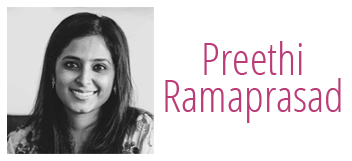ARTISTIC STATEMENT
I live in two worlds. One is the world of characters in Bharatanatyam and the other is the real world, where it increasingly necessary for us to connect. For me, Bharatanatyam has helped me make sense of the real world. My journey with this art has taken me from many trips in India as a young girl cultivating immersive experiences in expressive culture. Since then, I have been able to apply it through performance, practice, research, education, and other influences to create my own voice. Seeing the world through Bharatanatyam has aided me in coming to terms with failure and loss, while also helping me celebrate successes and relationships. My choreography tends to focus more on human emotion derived from Bharatanatyam technique, while my research discusses the politics of representation and belonging. Welcome to my website.
Preethi has very mobile facial expressions and this was evident in the treatment of the swarajati concluding on the note of the nayika seeing the sakhi off on her errand. In Papanasam Sivan’s composition Shivagamasundari in Mukhari, after the opening slokam set to Kalyani, the dancer as a woman praying to the Goddess, in the line “Gitavinodini Podum shodanai” tries to bring in the travails of the contemporary woman who as a single mother struggles to bring up her children and also as one separated from her children – the last a very felt response to recent American policies.
Leela Venkataraman, Asian Age, July 2018
Acknowledgement
In my position as a researcher, performer, and educator, I respectfully acknowledge the original and current hereditary practitioners of this art. In doing so, I recognize the multiple fraught histories of Bharatanatyam and its affiliated arts. I recognize that the intersections of race, class, caste, gender, sexuality, among other entities have enabled me in practicing this art form to the extent that I have.
This acknowledgment is part of my commitment: to confront exclusions and attempted erasures of Indigenous, Black, and Brown peoples, and others; to accept/embrace/acknowledge peoples’ bodies in their wide range of capacities, abilities, forms, and qualities; to be radically inclusive of queer peoples and bodies in the world and in our field; to support peaceful human mobility across land and waters for all; to being a good guest in travel; to being in a respectful relationship to the land wherever I am; and to building relationships–including becoming a good ally and accomplice. I continue to work creatively towards enacting practices and policies that register these histories and strengthen these layers of knowledge and ways of being.
Adapted from UCR Department of Dance Acknowledgement of Land and People
Webpage Photography Credit: Manasi Mahesh, Shankar Ramachandran, Sindhu Ramachandran, Jose Eduardo, RN Sudhi, Kaushik Jay, Chella Video, Nitish Adla, Mohit Mehra
Homepage Video Credit: Olana Flynn, Chella Video, Edited by Preethi Ramaprasad

